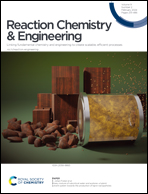Electrocatalytic and photocatalytic activity of CuTiO3 perovskites for complete degradation of methylene blue under sunlight irradiation†
Abstract
This study aims to synthesize inexpensive copper titanate (CuTiO3) perovskites as photocatalysts by a simple solvothermal method by varying the molar ratios of Cu2+ (0.10, 0.15, and 0.20 M) for degradation of methylene blue dye. By using XRD, FESEM, EDS, HRTEM, SAED, FTIR, UV-visible, PL, XPS, EIS, CV, and BET analyses, the relevant perovskites' structural, morphological, optical, and catalytic characteristics were studied. CuTiO3 has a monoclinic structure based on a structural study using XRD, and SEM and HR-TEM studies show an irregular sphere-like morphology. At a CuTiO3-modified carbon paste electrode, the electrochemical behaviour of MB was studied. 0.20 M CuTiO3 perovskites revealed superior photocatalytic activity compared to 0.10 M CuTiO3 and 0.15 M CuTiO3. Based on the outcomes of the BET, PL, EIS, and ˙OH trapping analyses, the enhanced photocatalytic activity was primarily ascribed to the high surface area, effective separation of photo-induced electron–hole pairs, and generation of highly active hydroxyl radical species in 0.20 M CuTiO3 perovskites. Experimental parameters including 0.20 M CuTiO3 perovskite dosage, the MB dye solution's starting concentration, and pH were changed to ascertain the optimal conditions for photocatalytic degradation. The findings show that the MB dye completely (98.56%) degrades in aqueous solution when exposed to sunlight for 60 minutes. The reusability of the as-prepared 0.20 M CuTiO3 was also investigated to ensure its stability during the degradation of MB. Furthermore, the scavenger experiment verified that hydroxyl radicals were key players in the degradation process. The proposed photocatalytic degradation mechanism for MB dye using 0.20 M CuTiO3 perovskites is provided. Therefore, it can be very interesting for research on energy and environmental applications in the future.



 Please wait while we load your content...
Please wait while we load your content...